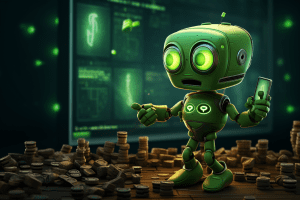The internet has come a long way-from simple web pages (Web 1.0) to engaging social media platforms (Web 2.0). Now we’re moving towards an advanced and intelligent network known as Web 3.0. This latest development has introduced a fresh perspective on internet usage and opened doors for advanced user interaction, information distribution, and content creation.
Web 3.0 uses top-notch technologies such as blockchain, artificial intelligence (AI), and machine learning (ML) to secure your online information and simplify data sharing while keeping you in full control of your online experience.
Table of Contents
Web 3.0’s Groundbreaking Achievement: Decentralized Finance (DeFi)
One of Web 3.0’s significant progresses is Decentralized Finance (DeFi). This innovation allows for secure, peer-to-peer financial transactions without the need for banks or other intermediaries, making it easier for everyone to access financial services.
DeFi applications can do everything from lending to offering insurance, all thanks to the power of virtual currencies. Some noteworthy DeFi platforms include Uniswap, Aave, and Compound, known for their reduced costs, high-speed transactions, and improved privacy due to their decentralization.
Non-Fungible Tokens (NFTs): Redefining Digital Ownership
Another important product of Web 3.0 is the Non-Fungible Tokens (NFTs). Unlike common cryptocurrencies like Bitcoin or Ethereum, each NFT is unique, providing a whole new way to own digital assets. This unique characteristic of NFTs has widened the reach of digital ownership, especially in the digital art, music, and virtual real estate markets.
The usage of NFTs has been adopted globally, enabling artists to authenticate their work and connect directly with their audience.
Decentralized Autonomous Organizations (DAOs): Revolutionizing Organizational Structures
Web 3.0 has also introduced Decentralized Autonomous Organizations (DAOs). These online organizations are run by smart contracts, eliminating the need for centralized authority and encouraging community involvement and shared ownership.
Web 3.0 Browsers: Increasing User Privacy and Control
Thanks to Web 3.0, we now have browsers that prioritize user privacy. Browsers such as Brave and Opera, equipped with blockchain technology, allow users to earn cryptocurrency rewards and use decentralized applications (DApps). They also enhance the user’s privacy by cutting down on the need for third-party cookies and trackers.
Interoperability: Connecting Multiple Blockchains
Interoperability, another significant step forward made possible by Web 3.0, allows different blockchain networks to communicate and interact with one another. This interconnection can improve the functionality and scalability of blockchain technology by letting information and value flow across multiple blockchains.
While there are many benefits to Web 3.0, it also comes with its own set of challenges. Areas such as decision-making within DAOs and managing cross-chain transactions demand careful attention. To successfully use Web 3.0, we will need to overcome these hurdles while prioritizing security and user privacy.
Looking Ahead: The Internet’s Bright Future
Web 3.0 marks a significant advancement in the evolution of the internet. With its impressive strides in decentralization, digital ownership, and interconnectivity, it’s reshaping how we engage with the digital world. As we continue our journey with Web 3.0, the forecast is filled with game-changing innovations that will redefine our online experiences, ultimately making the virtual world more inclusive and empowering.
What is web 3.0?
Web 3.0 is a name for the upcoming version of the internet. It uses advanced technology to spread information. This makes digital services better, safer, and able to work together. Web 3.0 is already changing things, like online voting and business models that respect your privacy. This new web version changes how we use the internet.
Web 3.0 definition and examples
Web 3.0 is a term people use to talk about the next stage of the internet. This new version is all about making the web a place where services aren’t controlled by one group. It also aims to make the web safer and gives users more control over their online details. Some key Web 3.0 technologies are distributed ledger technology (DLT), artificial intelligence (AI), and blockchain.
Let’s look at some examples of Web 3.0:
- Decentralized Apps (DApps): These are apps that function on a network that isn’t controlled by one source, instead of depending on a single server.
- Distributed Ledger Technology (DLT): This is a safe, unchangeable way to keep records online.
- Digital Tokens and Currencies: This is online money, like cryptocurrency, that are made, traded, and kept using blockchain technology.
- Smart Contracts: These are automatic agreements that function on a distributed ledger system and can be set to do tasks without needing anyone else to step in.



